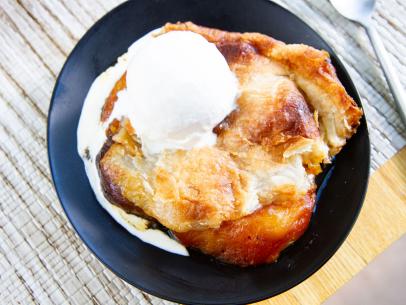
Recipe courtesy of Daniel Boulud
Recipe courtesy of Daniel Boulud
Watch how to make this recipe.
Tarte Tatin
Getting reviews...
- Level: Advanced
- Total: 4 hr 5 min
- Active: 1 hr 30 min
- Yield: 8 servings
-
- Nutritional Analysis
- Per Serving
- Serving Size
- 1 of 8 servings
- Calories
- 1016
- Total Fat
- 28 g
- Saturated Fat
- 17 g
- Carbohydrates
- 196 g
- Dietary Fiber
- 8 g
- Sugar
- 168 g
- Protein
- 5 g
- Cholesterol
- 71 mg
- Sodium
- 194 mg
Chef Boulud's version of this iconic French dessert uses apples poached in a vanilla infusion for exquisite flavor in every bite. They're bound together with a simple caramel that gives this tarte its beautiful copper shine. Allow the tarte to rest overnight before unmolding for a successful “voilà” moment. (Note: This is an advanced recipe, but practice makes perfect!)
- Level: Advanced
- Total: 4 hr 5 min
- Active: 1 hr 30 min
- Yield: 8 servings
-
- Nutritional Analysis
- Per Serving
- Serving Size
- 1 of 8 servings
- Calories
- 1016
- Total Fat
- 28 g
- Saturated Fat
- 17 g
- Carbohydrates
- 196 g
- Dietary Fiber
- 8 g
- Sugar
- 168 g
- Protein
- 5 g
- Cholesterol
- 71 mg
- Sodium
- 194 mg
Ingredients
Poaching Liquid
Tarte Tatin
Directions
- Poaching liquid: In a 5-quart pot, bring water, sugar, and butter to a boil, whisking occasionally. Use a paring knife to split the vanilla bean in half lengthwise; scrape the seeds from the pod and reserve for caramel. (Chef Boulud wipes the seeds onto the butter reserved for the caramel.) Add the scraped vanilla pod and the lemon juice to the poaching liquid.While the poaching liquid comes to a boil, prep the apples.
- Prep apples: Peel apples, then cut each into 4 wedges. Trim the top and bottom of each wedge and cut away the core. Set apple wedges aside.
- Make caramel: Preheat oven to 375 degrees F. In a 8 x 2¼-inch sauté pan over medium heat, add sugar. Stir slowly and gently, keeping a close eye on it; when a little over half the sugar has melted, reduce heat to low and continue stirring. After a total of 6–7 minutes, sugar should be caramelized, brown, and 350 F on an instant-read thermometer. Turn off the heat and add the reserved vanilla seeds and butter. Stir vigorously to combine; then allow caramel cool, 10-15 minutes.
- Poach apples: Once the poaching liquid is at a boil, reduce to a simmer and add the apples. Raise the heat to bring the liquid back to a simmer. Gently stir the apples every 5 minutes to ensure even cooking, rotating the apples from the top of the pot to the bottom. (White foam may form on the surface, which is normal; it does not need to be removed.) Simmer until apples are tender and a knife can easily pierce through, 15-20 minutes. Set a colander over a bowl and use a strainer to very gently transfer apples to the colander. Discard poaching liquid.
- Spread poached apples on a parchment-lined baking sheet to stop the cooking. (Optional: Allow apples to cool for 10 minutes for easier handling.) Begin placing apples around the perimeter of the sauté pan on top of the caramel, upright and nesting inside one another. Continue wedging apples into the pan in concentric circles, as tightly as possible; nearly every piece should fit into the pan. (If one or two remain, that’s the chef’s snack!) Once the pan is tightly packed, use the back of a spoon to gently press the apples down, to remove any air pockets. Discard vanilla bean.Place pan over low heat until caramel is bubbly around the apples, 5 minutes. Use a spoon to baste the apples with the caramel, then place on a rimmed baking sheet lined with parchment paper. Bake in the oven for 20 minutes. (Total baking time will be 60–75 minutes.) Note: Caramel may bubble out of the pan and onto the baking sheet, which is normal!
- While the apples are baking, wrap the bottom and outside of the slightly smaller pot in aluminum foil. After the apples have been baking for 20-25 minutes, remove from oven. Place sauté pan on a rack fitted over a parchment-lined rimmed baking sheet. Gently press the bottom of the wrapped pot on the apples to fully submerge them into the caramel and flatten the top. (Some caramel may overflow onto the baking sheet.) Set aside the smaller pot and place the apples back into the oven for 30–35 more minutes, removing to press the apples every 15 minutes.
- After a total of about 60 minutes of baking, the apples will have absorbed most of the caramel and be concentrated in the sauté pan. Remove from the oven and increase oven temperature to 400 F. Roll pastry: Remove puff pastry from refrigerator. Dust a work surface with flour and roll pastry to a ¼-inch thickness, rotating the pastry as you roll; dust with additional flour as needed. Cut the flattened pastry into a circle just a little larger than the diameter of the sauté pan, using the lid as a guide. Use a fork to poke holes all over the pastry: this is called "docking" and will keep the pastry from over-puffing. Place docked pastry on top of the apples; it's fine if the pastry is at the edge of the pot, since it will shrink slightly as it bakes. Bake until pastry is lightly golden brown, about 15 minutes.
- Remove tarte Tatin from oven and let cool completely, at least 1 hour; cooling overnight at room temperature is recommended. (Unmolding the tarte when it is still warm may cause it to fall apart.) Once cool, warm the pan over medium heat for 1 minute; this will help the tarte Tatin come out of the pan more easily. Remove from heat and run a paring knife around the outer edge of the tarte to gently release the apples from the side of the pan. Place a serving platter over the pan; holding the platter firmly to the pan with a kitchen towel, quickly and carefully invert to flip the tarte Tatin onto the platter. Serve with whipped cream, vanilla ice cream, or crème fraîche (optional).

































